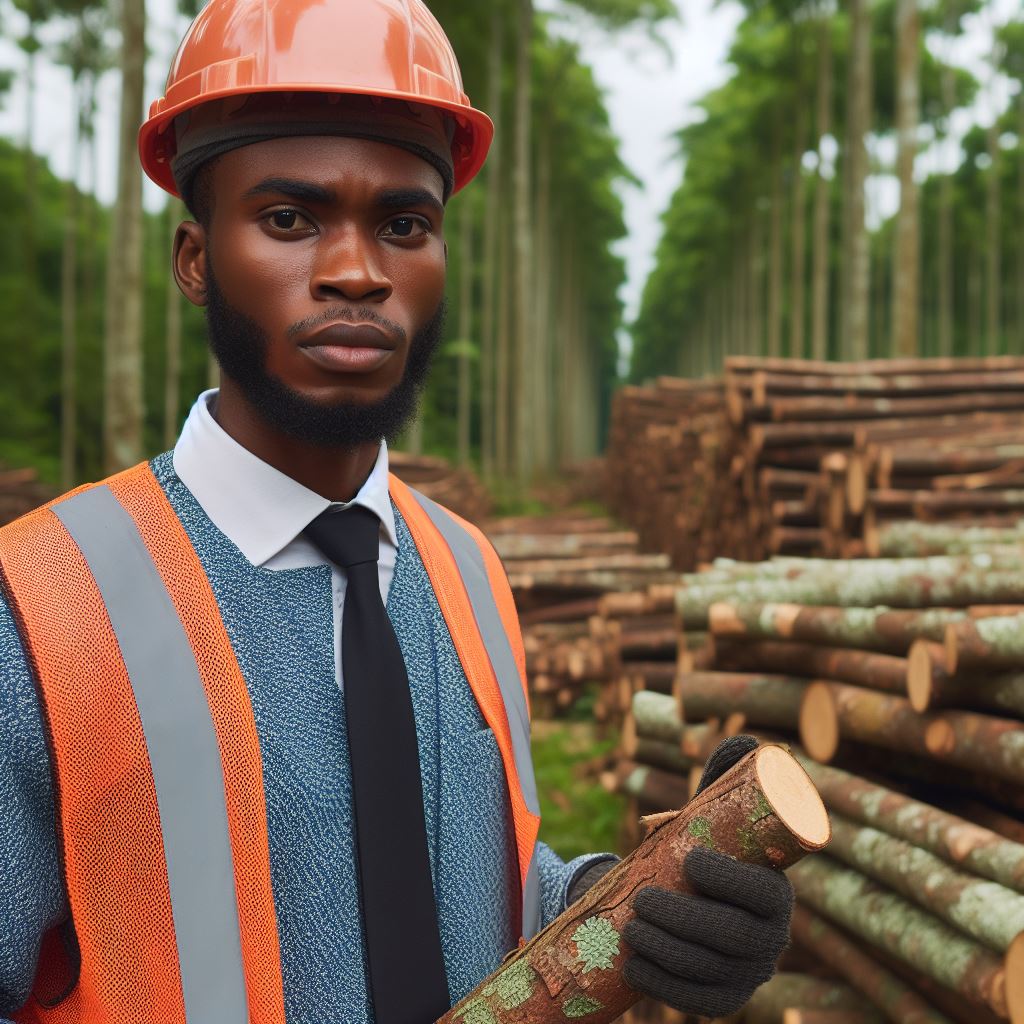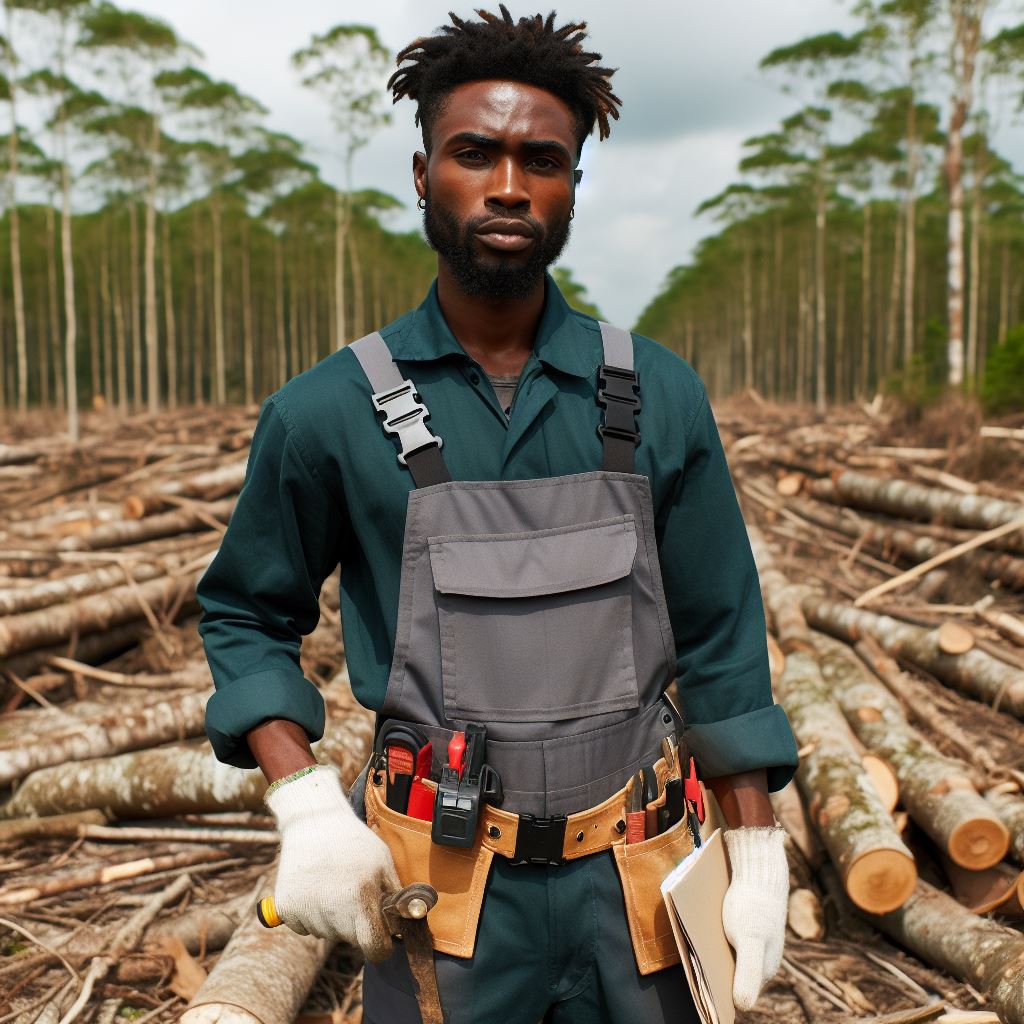Introduction
Nigeria, endowed with diverse ecosystems and abundant natural resources, has recognized the pivotal role of forestry education in sustainable environmental management.
As the nation grapples with deforestation, climate change, and the need for responsible resource utilization, a well-rounded forestry education system becomes indispensable.
Educating the next generation of foresters and environmental stewards is crucial to ensure the preservation of Nigeria’s rich biodiversity and ecological balance.
In the 21st century, the landscape of education is rapidly evolving, and forestry education is no exception.
Modern technologies and tools have emerged as game-changers, revolutionizing the way students learn and professionals operate in the forestry sector.
From Geographic Information Systems (GIS) mapping to remote sensing and data analytics, these tools empower students and practitioners to make informed decisions, manage forest resources efficiently, and address environmental challenges effectively.
This blog post explores the symbiotic relationship between modern technologies and forestry education in Nigeria.
We will delve into the significance of forestry education, shedding light on its role in sustainable environmental management.
Furthermore, we will dissect the transformative impact of cutting-edge technologies and tools, unraveling how they are reshaping the educational landscape and empowering forestry professionals to navigate the complexities of the 21st-century forestry sector.
As we embark on this journey, we will navigate through the intersections of education, technology, and environmental conservation, highlighting success stories, challenges, and the promising future that lies ahead.
Join us in unraveling the transformative potential of modern technologies in Nigerian forestry education, as we collectively strive for a greener, more sustainable future.
Traditional Methods in Nigerian Forestry Education
Overview of traditional teaching methods and tools used in forestry education
- Lectures delivered by instructors using textbooks, handouts, and blackboards.
- Field trips organized to provide practical knowledge and understanding of forest ecosystems.
- Group discussions and presentations to encourage active participation and knowledge sharing.
- Practical exercises, such as tree measurement and wood identification, to develop hands-on skills.
- Examinations and quizzes to assess students’ theoretical knowledge and understanding.
- Research projects assigned to develop critical thinking and analytical skills.
Limitations and challenges of relying solely on traditional methods
- Passive learning environment that lacks student engagement and interaction.
- Limited access to up-to-date information and technological advancements.
- Dependency on physical resources, such as textbooks and blackboards, which may be outdated or inadequate.
- Inability to provide real-time feedback and personalized learning experiences.
- Lack of practical skills development, as traditional methods focus more on theoretical knowledge.
- Difficulty in addressing individual learning needs and catering to diverse student backgrounds.
- Limited opportunities for collaborative learning and networking among students.
Additionally, relying solely on traditional methods restricts opportunities for collaborative learning and networking among students.
Modern technologies and tools can bridge these gaps by creating interactive learning environments, providing access to digital resources, and facilitating personalized and adaptive learning experiences.
In fact, while traditional methods have been the mainstay of Nigerian forestry education, they come with inherent limitations and challenges.
Integrating modern technologies and tools into forestry education can enhance student engagement, provide up-to-date information, foster practical skills development, and cater to individual learning needs.
Embracing these advancements is crucial for the evolution and improvement of forestry education in Nigeria.
Read: The Link between Forestry and Nigerian Biodiversity Conservation
Introduction of Modern Technologies and Tools
The various modern technologies and tools applicable in forestry education
- Remote sensing: Using drones and satellite imagery to gather data on forest resources.
- Geographic Information System (GIS): Helps in mapping and analyzing forest resources and planning.
- Global Positioning System (GPS): Accurate navigation and location information for fieldwork.
- Forest inventory software: Collects and analyzes data on trees, growth, and forest health.
- Smartphone applications: Assist in identifying tree species, pests, and diseases, and provide educational material.
- Data analysis and modeling: Use statistics and algorithms to make predictions and assess forest ecosystem dynamics.
Examples of modern technologies and tools used in other countries and their benefits
- In Finland, laser scanning technology is used to accurately measure tree heights, biomass, and carbon content.
- In Canada, forest inventory software helps monitor tree growth, disease outbreaks, and timber harvest patterns.
- In the United States, drones assist in monitoring forest fires, damage assessment, and post-disaster recovery.
- In Australia, smartphone apps provide information on bushfire alerts, biodiversity, and sustainable forestry practices.
- In Japan, computer simulation models are used to predict the impact of forest management decisions on timber production.
Importance of integrating modern technologies and tools in Nigerian forestry education
- Enhances data collection and analysis, leading to informed decision-making in forest management.
- Improves forest monitoring and surveillance capabilities, reducing illegal logging and promoting sustainability.
- Increases efficiency and accuracy in resource mapping and inventory, enabling better planning and conservation strategies.
- Offers interactive and engaging learning experiences for students, fostering their interest and understanding in forestry.
- Facilitates international collaborations and knowledge exchange, keeping Nigerian forestry education up-to-date with global advancements.
- Supports sustainable forest practices, biodiversity conservation, and climate change mitigation efforts in Nigeria.
- Strengthens the capacity of forestry professionals by equipping them with up-to-date skills and knowledge.
Read: Community Involvement and Participation in Forestry Projects in Nigeria

Applications of Modern Technologies and Tools in Nigerian Forestry Education
Introduction of specific modern technologies and tools being utilized in Nigeria
Nigerian forestry education has experienced a significant transformation with the introduction and adoption of various modern technologies and tools.
These advancements have revolutionized the teaching and learning processes, providing students with enhanced opportunities to understand and engage with the subject matter.
One particular technology that has made a significant impact is Geographic Information Systems (GIS).
GIS allows students to analyze spatial data and make informed decisions regarding forest management and conservation efforts.
It enables them to capture, store, manipulate, analyze, and display spatial information, providing a comprehensive understanding of forest ecosystems.
In addition to GIS, remote sensing technology has also been integrated into forestry education in Nigeria.
This technology involves the use of satellite imagery to monitor and analyze the condition and extent of forest resources.
It provides valuable information on forest cover, biodiversity, and deforestation rates, supporting data-driven decision-making in forestry management.
Another vital tool in Nigerian forestry education is computer-aided design (CAD) software.
CAD software enables students to create and analyze digital models of forest landscapes, enabling them to develop and evaluate sustainable management plans.
It allows for the visualization of various design options and facilitates accurate simulations of different scenarios.
Description of how these technologies and tools are being used in forestry education
These modern technologies and tools are being integrated into various aspects of forestry education in Nigeria.
In the classroom, instructors utilize GIS software to create interactive maps and conduct exercises that require students to analyze real-world forestry data.
Through these exercises, students develop critical thinking skills and gain practical experience in spatial analysis.
Remote sensing technology is used to assess the health and condition of forests, providing students with firsthand experience in monitoring forest resources.
They learn to interpret satellite imagery, identify changes in forest cover, and analyze the impact of deforestation.
This hands-on approach enhances their understanding of the challenges faced in forest conservation.
CAD software is employed to design and evaluate sustainable forest management plans.
Students can simulate different management scenarios, assess the potential outcomes, and make informed decisions based on the results.
This enables them to develop practical solutions to complex forestry problems.
Examples of successful implementation and their impact on students’ learning experiences
The implementation of these modern technologies and tools in Nigerian forestry education has yielded positive results.
For instance, at the University of Nigeria, students using GIS software have demonstrated improved understanding of forest ecosystems and their dynamics.
Transform Your Career with Expert Guidance
Get personalized mentorship consulting that’s tailored to your unique path. Our expert advice is actionable and exclusive.
Get StartedThey have also shown increased proficiency in spatial analysis and decision-making.
Furthermore, at the Federal College of Forestry, Ibadan, the integration of remote sensing technology has enabled students to monitor deforestation rates in real-time.
This has heightened their awareness of the consequences of deforestation and motivated them to actively participate in reforestation efforts.
As a result, the college has seen a significant increase in the number of students engaging in community-based forestry projects.
Moreover, the use of CAD software at the University of Ibadan has empowered students to develop comprehensive management plans for forest reserves.
By simulating different management scenarios, they can identify potential challenges and devise appropriate strategies to address them.
This hands-on approach has fostered practical skills and enhanced their employability upon graduation.
In essence, the integration of modern technologies and tools in Nigerian forestry education has brought about transformative changes in teaching and learning.
Through the use of GIS, remote sensing, and CAD software, students are equipped with practical skills and knowledge to effectively manage and conserve forest resources.
The successful implementation of these technologies has not only improved students’ learning experiences but also contributed to the sustainable development of Nigeria’s forests.
Read: The Intersection: Family Values and Consumer Behavior in Nigeria
You Might Also Like: Public Awareness Campaigns for Wildlife Management in Nigeria
Benefits of Integrating Modern Technologies and Tools in Forestry Education
In the dynamic landscape of Nigerian forestry education, the integration of modern technologies and tools has ushered in a new era of unparalleled benefits.
These advancements not only bridge the gap between traditional classroom teachings and real-world applications but also offer a myriad of advantages for both educators and students alike.
Improved Access to Relevant and Up-to-Date Information
One of the foremost benefits of incorporating modern technologies in forestry education is the seamless access to relevant and up-to-date information.
With the click of a button, students can delve into comprehensive databases, research papers, and case studies that reflect the latest trends and practices in forestry.
This ensures that the curriculum remains current and aligns with the rapidly evolving field, empowering students with the knowledge necessary to navigate the intricacies of modern forestry.
Enhanced Practical Skills Development for Students
Modern technologies provide a dynamic platform for hands-on learning experiences, fostering the development of practical skills among forestry students.
Virtual simulations, augmented reality, and interactive software enable students to engage in lifelike scenarios, honing their abilities in areas such as tree identification, forest mapping, and sustainable resource management.
These immersive experiences not only augment theoretical knowledge but also prepare students for the challenges they will face in the field, equipping them with a skill set that transcends the confines of traditional education.
Increased Student Engagement and Motivation
The integration of technology injects a sense of excitement and relevance into forestry education, leading to increased student engagement and motivation.
Interactive learning modules, online forums, and collaborative platforms create an environment where students actively participate in their educational journey.
The gamification of certain aspects of the curriculum further incentivizes learning, making complex concepts more digestible and enjoyable.
This heightened engagement not only enhances the overall learning experience but also cultivates a passion for forestry that extends beyond the classroom.
In a nutshell, the benefits of integrating modern technologies and tools into Nigerian forestry education are vast and transformative.
By improving access to information, enhancing practical skills development, and fostering increased student engagement, these advancements propel forestry education into a dynamic realm that prepares students for the challenges and opportunities of the modern forestry industry.
Read: Pioneers of Family & Consumer Sciences Education in Nigeria
Challenges and Potential Solutions
Potential challenges in implementing modern technologies and tools in forestry education in Nigeria
- Limited access to technology and internet connectivity among forestry educators and institutions.
- Inadequate funding for acquiring and maintaining modern technologies and tools.
- Lack of technical skills and knowledge in using modern technologies and tools.
- Resistance to change and reluctance to incorporate new technologies into traditional teaching methods.
- Inconsistent electricity supply, hindering the use of technology-dependent tools.
Possible solutions to overcome these challenges
- Investment in infrastructure development to enhance internet connectivity in forestry education institutions.
- Allocation of sufficient funds for procuring and regularly updating modern technologies and tools.
- Organizing training programs to impart necessary technical skills and knowledge to forestry educators.
- Creating awareness and promoting the benefits of integrating modern technologies into forestry education.
- Exploring alternative power sources, such as solar energy, to overcome electricity supply issues.
Importance of training forestry educators on using modern technologies and tools effectively
Training forestry educators on utilizing modern technologies and tools effectively is vital for various reasons:
- Enhanced teaching and learning experiences through the use of interactive and engaging technologies.
- Improved efficiency and accuracy in data collection, analysis, and research in the field of forestry.
- Enhanced collaboration and communication among educators, students, and forestry professionals.
- Preparation of students for the demands and expectations of the modern forestry industry.
- Empowerment of educators to stay updated with the latest advancements and trends in forestry.
Essentially, while there may be potential challenges in implementing modern technologies and tools in Nigerian forestry education, there are viable solutions available.
By addressing the limited access to technology, inadequate funding, lack of technical skills, resistance to change, and inconsistent electricity supply, the integration of modern technologies can become a reality.
Moreover, training forestry educators on effectively utilizing these technologies is crucial for improved teaching and learning experiences, efficient data collection and analysis, enhanced collaboration, and preparing students for the future of forestry.
Embracing modern technologies and tools in Nigerian forestry education can lead to significant advancements in the field and contribute to sustainable forest management in the country.
You Might Also Like: Career Opportunities in Wildlife Management in Nigeria
Find Out More: Digital Platforms for Livestock Market in Nigeria
Conclusion
In this post, we have explored the importance of integrating modern technologies and tools in Nigerian forestry education.
We highlighted the benefits they bring, such as improved data collection, analysis, and decision-making processes.
We also discussed how these advancements can enhance the practical skills of students and prepare them for the evolving industry.
By incorporating modern technologies and tools into forestry education, Nigerian students will be better equipped to face the challenges of a rapidly changing field.
These innovations can bridge the gap between theoretical knowledge and practical application.
Students will gain a competitive edge in the job market and contribute to sustainable forest management practices in Nigeria.
It is crucial for policymakers, educators, and stakeholders to recognize the significance of modern technologies and tools in forestry education.
They must allocate resources and invest in training programs, infrastructure, and research to ensure that Nigerian forestry students receive the necessary exposure and competence in utilizing these advancements.
By doing so, we can foster a skilled workforce capable of addressing the challenges that lie ahead for the forest industry in Nigeria.
In summary, integrating modern technologies and tools in Nigerian forestry education is essential for the progress of the sector.
By embracing these advancements, we can enhance students’ skills, improve decision-making processes, and promote sustainable forest management practices.
It is our collective responsibility to prioritize and invest in these technologies and tools to secure a prosperous future for our forestry sector.




